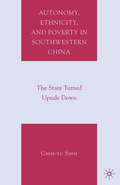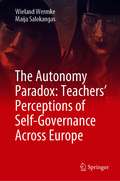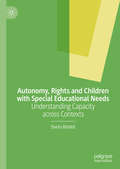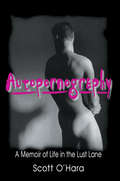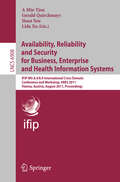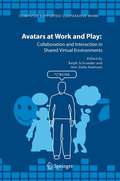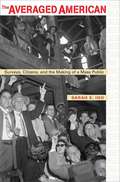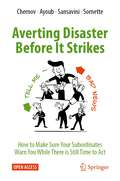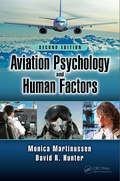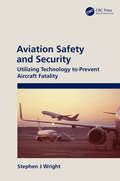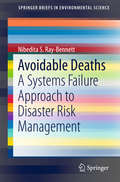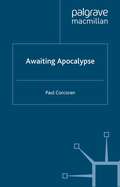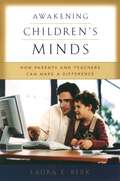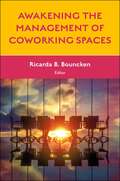- Table View
- List View
Autonomy, Ethnicity, and Poverty in Southwestern China: The State Turned Upside Down
by C. ShihThe Chinese state reaches out to ethnic communities in three different channels of autonomy, ethnicity, and poverty. However, each of these channels designates a submissive position to ethnic citizenship. Amidst theoretical uncertainty on how the state has affected local communities, ethnic minorities can develop subjectivity. Through this, they can sincerely participate in the state's policy agenda, conveniently incorporate the state into the ethnic identity, give feedback to the state within the framework of official discourse, or hide behind the state to evade ethnic identification. Rather than finding a life outside the state, the ethnic communities can, in one way or another, position themselves inside the state.
The Autonomy Paradox: Teachers’ Perceptions of Self-Governance Across Europe
by Wieland Wermke Maija SalokangasWhat do we mean when we speak about teacher autonomy? How free are teachers to go about their work? To answer these complex questions the authors asked thousands of teachers in four national contexts: in Finland, Ireland, Germany and Sweden, what they think autonomy looks like. The resulting book examines teacher autonomy theoretically and empirically, comparing teachers’ perceptions of their professional autonomy. Utilizing a mixed method approach the authors combine data from a large-scale questionnaire study, teacher interviews, lesson and meeting observations, and workshops that brought together teachers from the four participating countries. All this engagement with teachers revealed that simply increasing their professional autonomy might not lead to desired outcomes. This is because, from a teachers’ point of view, increased decision-making capacity brings further complexity and risk to their work, and it may instead lead to anxiety, self-restriction, and the eventual rejection of autonomy. These surprising conclusions challenge the increasingly orthodox view that increased autonomy is a desirable end in itself. This is what the authors call the autonomy paradox.
Autonomy, Rights and Children with Special Educational Needs: Understanding Capacity across Contexts
by Sheila RiddellThis books examines the increased prominence of children’s rights in education to ask whether we are witnessing a paradigm shift within the education system. The author uses a wide range of case studies from Scotland and England to examine the extent to which children and young people with Special Educational Needs/ Additional Support Needs are in practice able to realise their new rights of participation and redress. In addition, the book examines the ways in which the child’s capacity to make independent decisions is understood and acted upon in different contexts, and the factors which ultimately promote or inhibit the rights of young people and children with SEN/ ASN. The author asks whether, in a context of tight budgets and often limited support, this new emphasis on children's rights can be seen as ‘window-dressing’ and a distraction from reductions in support for social welfare.
Autopornography: A Memoir of Life in the Lust Lane
by Scott O' HaraIn this provocative book, retired porn star Scott O’Hara (known as “Spunk” by many of his fans from an early punk photospread) gives a backstage look at the world of pornography, revealing why he loved it, what he got out of it, and why he left it. In an autobiographical style, he considers and poses answers to some fascinating questions: What is sex? What makes a porn star? And why does pornography really upset people? You’ll really get to know this noted gay porn star as you get a firsthand look at his life experiences and sexual journeys from his boyhood days of locker room fantasies and sexual experimentation to his years as a porn star and then to his experiences as an individual facing the realities of being HIV-positive. As O’Hara puts it in his Introduction: “This book was written as a last-ditch effort: a way to open up all my closets, let you in on all the dark corners of my life, and give you a better picture of what goes into the making of a porn star. Because if there’s one profession that arouses people’s curiosity, it’s that one.” As you read through the pages of Autopornography, you’ll see how O’Hara’s personality reflects his sexuality, that is, how they have melded into one. His vivid descriptions of personal relationships (with family, friends, lovers, and casual acquaintances) and his many sexual encounters as he traveled the world reveal his love of sex and his desire to live without inhibitions, secrets, or sexual constraints. Reading Autopornography may cause you to reexamine your own sexual boundaries, realize new sexual potential, and discover sexual desires not previously aroused.Listed #14 on Books Bought Mainly by Men 1997 Top 100 Bestsellers as rated by A Different Light Bookstore!
Autopornography: A Memoir of Life in the Lust Lane
by Scott O' HaraIn this provocative book, retired porn star Scott O’Hara (known as “Spunk” by many of his fans from an early punk photospread) gives a backstage look at the world of pornography, revealing why he loved it, what he got out of it, and why he left it. In an autobiographical style, he considers and poses answers to some fascinating questions: What is sex? What makes a porn star? And why does pornography really upset people? You’ll really get to know this noted gay porn star as you get a firsthand look at his life experiences and sexual journeys from his boyhood days of locker room fantasies and sexual experimentation to his years as a porn star and then to his experiences as an individual facing the realities of being HIV-positive. As O’Hara puts it in his Introduction: “This book was written as a last-ditch effort: a way to open up all my closets, let you in on all the dark corners of my life, and give you a better picture of what goes into the making of a porn star. Because if there’s one profession that arouses people’s curiosity, it’s that one.” As you read through the pages of Autopornography, you’ll see how O’Hara’s personality reflects his sexuality, that is, how they have melded into one. His vivid descriptions of personal relationships (with family, friends, lovers, and casual acquaintances) and his many sexual encounters as he traveled the world reveal his love of sex and his desire to live without inhibitions, secrets, or sexual constraints. Reading Autopornography may cause you to reexamine your own sexual boundaries, realize new sexual potential, and discover sexual desires not previously aroused.Listed #14 on Books Bought Mainly by Men 1997 Top 100 Bestsellers as rated by A Different Light Bookstore!
Autoritäre Dynamiken in der Krise: Drei Fallstudien zu Agitation und autoritären Reaktionen in der Covid-19-Pandemie (Kritische Sozialpsychologie)
by Julia König Markus Brunner Anna Domdey Nicola Graage Dustin HenzeAls eine globale Krise hatte die Covid-19-Pandemie nicht nur gesundheitliche und wirtschaftliche Folgen, sondern löste auch politische und gesellschaftliche Veränderungen aus. Wie reagierten die Menschen hierauf und welche autoritären Dynamiken wurden dabei sichtbar? Aus einer psychoanalytisch-sozialpsychologischen Forschungsperspektive und in Anknüpfung an die Autoritarismusforschung der Kritischen Theorie untersuchen drei empirische Fallstudien - über Videos der Querdenker-Szene, Bundestagsreden der AfD sowie biografische Interviews - unterschiedliche Facetten autoritärer Agitation und Reaktion auf die Pandemie. Die Ergebnisse veranschaulichen, wie die Pandemie als ein Brennglas für gesellschaftliche Widersprüche und Konflikte wirkt, die sich subjektiv niederschlagen und durch verschwörungsideologische und rechtspopulistische Akteur:innen propagandistisch bedient werden. Die Erkenntnisse verweisen dabei auch auf mögliche Herausforderungen künftiger Krisen.
Autoritäre Sozialtypen: Eine empirische Studie (Frankfurter Beiträge zur Soziologie und Sozialpsychologie)
by Maurits HeumannWährend in der Öffentlichkeit intensiv darüber diskutiert wird, ob man ‚mit Rechten reden‘ sollte, geht dieses Buch einen Schritt weiter und untersucht die Perspektiven jener, die sich von solchen Debatten persönlich angegriffen fühlen. Basierend auf der Tradition der Frankfurter Autoritarismusforschung analysiert die Studie die ideologischen Spannungsfelder innerhalb der deutschen Gesellschaft und liefert wertvolle Einblicke in die widersprüchlichen politischen Positionen und biografischen Hintergründe der Befragten. Im Zentrum der Analyse stehen zwei identifizierte Sozialtypen des ‚neuen‘ Autoritarismus: die autoritären Innovator*innen und die regressiven Rebell*innen. Während erstere in stabilen sozialen Verhältnissen leben, sehen sich letztere zunehmend prekären Lebensumständen ausgesetzt. Entscheidend ist jedoch nicht allein die aktuelle soziale Lage, sondern vielmehr die individuelle Lebensgeschichte und der persönliche Werdegang. Die Analyse zeigt, dass individuelle Lebenswege eng mit ideologischen Reaktionsmustern verknüpft sind. Mit der Typologie leistet das Buch einen Beitrag für ein detaillierteres Verständnis der vielfältigen autoritären Phänomene unserer Zeit und der zugrunde liegenden sozialen Dynamiken.
Autorität reloaded: Eine Neukonzeption gegen Gewalteskalationen im Polizeidienst
by Susanne Vom HauAutorität ist das Thema dieses Buches. Eskalationen im Polizeidienst, die offenbar im Zuge der Individualisierung eine neue Qualität erreicht haben, erfordern ein Umdenken der Polizei. Das betrifft besonders das antiquierte Autoritätsverständnis der Polizei. Wie aber lässt sich in der offenen Gesellschaft, in der Über- bzw. Unterordnungsverhältnisse als voraufklärerisch gelten, ein Autoritätsanspruch der Polizei aufrechterhalten? Mit dem Ziel, die funktionale Ausrichtung der Polizei in der Gesellschaft den Befindlichkeiten des selbstbestimmten Bürgers im 21. Jahrhundert anzupassen, wird eine Neukonzeption von Polizeiautorität vorgelegt.
Availability, Reliability and Security for Business, Enterprise and Health Information Systems: IFIP WG 8.4/8.9 International Cross Domain Conference and Workshop, Vienna, Austria, August 22-26, 2011, Proceedings (Lecture Notes in Computer Science #6908)
by A. Min Tjoa Gerald Quirchmayr Ilsun You Lida XuThis book constitutes the refereed proceedings of the IFIP WG 8.4/8.9 International Cross Domain Conference and Workshop on Availability, Reliability and Security - Multidisciplinary Research and Practice for Business, Enterprise and Health Information Systems, ARGES 2011, held in Vienna, Austria, in August 2011.The 29 revised papers presented were carefully reviewed and selected for inclusion in the volume. The papers concentrate on the many aspects of availability, reliability and security for information systems as a discipline bridging the application fields and the well-defined computer science field. They are organized in three sections: multidisciplinary research and practice for business, enterprise and health information systems; massive information sharing and integration and electronic healthcare; and papers from the colocated International Workshop on Security and Cognitive Informatics for Homeland Defense.
Avatars at Work and Play: Collaboration and Interaction in Shared Virtual Environments (Computer Supported Cooperative Work #34)
by Ralph Schroeder Ann-Sofie AxelssonAvatars at Work and Play brings together contributions from leading social scientists and computer scientists who have conducted research on virtual environments used for collaboration and online gaming. They present a well-rounded and state-of-the-art overview of current applications of multi-user virtual environments, ranging from highly immersive virtual reality systems to internet-based virtual environments on personal computers. The volume is a follow-up to a previous essay collection, ‘The Social Life of Avatars’, which explored general issues in this field. This collection goes further, examining uses of shared virtual environments in practical settings such as scientific collaboration, distributed meetings, building models together, and others. It also covers online gaming in virtual environments, which has attracted hundreds of thousands of users and presents an opportunity for studying a myriad of social issues. Covering both ‘work’ and ‘play’, the volume brings together issues common to the two areas, including:What kind of avatar appearance is suitable for different kinds of interaction? How best to foster collaboration and promote usable shared virtual spaces? What kinds of activities work well in different types of virtual environments and systems?
The Averaged American: Surveys, Citizens, and the Making of a Mass Public
by Sarah E. Igosupports the death penalty, that half of all marriages end in divorce, and that four out of five prefer a particular brand of toothpaste. But remarkably, such data--now woven into our social fabric--became common currency only in the last century. With a bold and sophisticated analysis, Sarah Igo demonstrates the power of scientific surveys to shape Americans' sense of themselves as individuals, members of communities, and citizens of a nation.
Averting Disaster Before It Strikes: How to Make Sure Your Subordinates Warn You While There is Still Time to Act
by Dmitry Chernov Ali Ayoub Giovanni Sansavini Didier SornetteSome of the major industrial disasters could have been prevented. When the facts of what happened are established, their stories share a common thread: before things spiralled out of control, there were workers at the affected sites who knew that the situation was dangerous, and could become catastrophic unless immediate action was taken. But tragically, nobody dared to tell the decision-makers who could have authorized that action. With no idea of the risks they were taking, the people in charge continued as normal… and disaster struck. Because vital information about risks could not flow freely from the shop floor to the director’s office, the crucial decisions were not made in time. This observation has been documented in the following major technological accidents: Challenger space shuttle explosion (USA, 1986); Chernobyl nuclear plant disaster (USSR, 1986); Deepwater Horizon oil spill (USA, 2010); Fukushima-1 nuclear power plant disaster (Japan, 2011); and numerous other industrial disasters. After accidents like these, losses and costs for dealing with the consequences are often hundreds — or even thousands — of times greater than the finances that would have been required to deal with the risks when they were first recognized.This handbook is about how to transform the way large critical infrastructure companies communicate about safety and technological risks. It aims to support senior managers to get the information they need from their subordinates concerning the risks they are facing, in order to prevent accidents before it is too late.The recommendations in this handbook are based on interviews with 100 executives at various levels, working in 65 critical infrastructure companies around the world, in power, oil and gas, metals, chemicals and petrochemicals, mining and other industries.The recommendations of these leaders were also tested in the pilot project, in an industrial company which is the world leader in its sector. More than 400 managers at various levels of the corporate hierarchy, and employees at several of the company’s industrial plants, took part in the project.This open access handbook is written for the owners, senior managers, and industrial safety directors of critical infrastructure companies.
Aviation Instruction and Training (Routledge Revivals)
by Ross A. TelferFirst published in 1993. In both general aviation and airline transport there is evidence of an emergent awareness of the importance of instruction in training. The demands of technological change, growing need for pilots at a time when the pool of experienced applicants is diminishing, and growing recognition of the importance of Human Factors to aviation safety, are straining the ability to cope. There is a growing recognition by management, of the contribution of ground and airborne instruction to the efficient operation of aviation in a variety of contexts. This book shows how professionals in the aviation industry and academic researchers complement each other in their pursuit of more effective and efficient flight training and instruction. Theory and practice each have a contribution to make. The contributions are thus drawn from regulatory authorities, airlines, universities, colleges, flying schools, the armed services and private practice. Such a mix brings differences in approach, style and argument showing both the variety and common aims in the emerging profession of flight instruction.
Aviation Instruction and Training (Routledge Revivals)
by Ross A. TelferFirst published in 1993. In both general aviation and airline transport there is evidence of an emergent awareness of the importance of instruction in training. The demands of technological change, growing need for pilots at a time when the pool of experienced applicants is diminishing, and growing recognition of the importance of Human Factors to aviation safety, are straining the ability to cope. There is a growing recognition by management, of the contribution of ground and airborne instruction to the efficient operation of aviation in a variety of contexts. This book shows how professionals in the aviation industry and academic researchers complement each other in their pursuit of more effective and efficient flight training and instruction. Theory and practice each have a contribution to make. The contributions are thus drawn from regulatory authorities, airlines, universities, colleges, flying schools, the armed services and private practice. Such a mix brings differences in approach, style and argument showing both the variety and common aims in the emerging profession of flight instruction.
Aviation Psychology and Human Factors
by Monica Martinussen David R. HunterThis book covers the application of psychological principles and techniques to situations and problems of aviation. It offers an overview of the role psychology plays in aviation, system design, selection and training of pilots, characteristics of pilots, safety, and passenger behavior. It covers concepts of psychological research and data analysis and shows how these tools are used in the development of new psychological knowledge. The new edition offers material on physiological effects on pilot performance, a new chapter on aviation physiology, more material on fatigue, safety culture, mental health and safety, as well as practical examples and exercises after each chapter.
Aviation Psychology and Human Factors
by Monica Martinussen David R. HunterThis book covers the application of psychological principles and techniques to situations and problems of aviation. It offers an overview of the role psychology plays in aviation, system design, selection and training of pilots, characteristics of pilots, safety, and passenger behavior. It covers concepts of psychological research and data analysis and shows how these tools are used in the development of new psychological knowledge. The new edition offers material on physiological effects on pilot performance, a new chapter on aviation physiology, more material on fatigue, safety culture, mental health and safety, as well as practical examples and exercises after each chapter.
Aviation Safety and Security: Utilizing Technology to Prevent Aircraft Fatality
by Stephen J WrightThis book focuses on ways to better manage and prevent aircraft-based homicide events while in flight using alternate technology to replace the Cockpit Voice Recorder (CVR) and/or Digital Flight Data Recorder (DFDR) functions. While these events are infrequent, the implementation of real-time predictive maintenance allows aircraft operators to better manage both scheduled and unscheduled maintenance events. Aviation Safety and Security: Utilizing Technology to Prevent Aircraft Fatality explores historical events of in-flight homicide and includes relevant accident case study excerpts from the National Transportation Safety Board (NTSB) and Air Accidents Investigation Branch (AAIB). FEATURES Explores historical events of in-flight homicide and offers solutions for ways to mitigate risk Explains how alternate technologies can be implemented to address in-flight safety issues Demonstrates that metrics for change are not solely for safety but also for financial savings for aircraft operation Includes relevant accident case study excerpts from the NTSB and AAIB Expresses the need for real-time predictive maintenance Stephen J Wright is an academic Professor at the faculty of Engineering and Natural Sciences at Tampere University, Finland, specializing in aviation, aeronautical engineering, and aircraft systems.
Aviation Safety and Security: Utilizing Technology to Prevent Aircraft Fatality
by Stephen J WrightThis book focuses on ways to better manage and prevent aircraft-based homicide events while in flight using alternate technology to replace the Cockpit Voice Recorder (CVR) and/or Digital Flight Data Recorder (DFDR) functions. While these events are infrequent, the implementation of real-time predictive maintenance allows aircraft operators to better manage both scheduled and unscheduled maintenance events. Aviation Safety and Security: Utilizing Technology to Prevent Aircraft Fatality explores historical events of in-flight homicide and includes relevant accident case study excerpts from the National Transportation Safety Board (NTSB) and Air Accidents Investigation Branch (AAIB). FEATURES Explores historical events of in-flight homicide and offers solutions for ways to mitigate risk Explains how alternate technologies can be implemented to address in-flight safety issues Demonstrates that metrics for change are not solely for safety but also for financial savings for aircraft operation Includes relevant accident case study excerpts from the NTSB and AAIB Expresses the need for real-time predictive maintenance Stephen J Wright is an academic Professor at the faculty of Engineering and Natural Sciences at Tampere University, Finland, specializing in aviation, aeronautical engineering, and aircraft systems.
Avoidable Deaths: A Systems Failure Approach to Disaster Risk Management (SpringerBriefs in Environmental Science)
by Nibedita S. Ray-BennettThis book addresses one of the most fundamental questions of the 21st century: why deaths continue to occur in natural disasters despite the tremendous advancements in disaster management science and weather forecasting systems, increased sophistication of human-built environments and ongoing economic and policy development worldwide. By presenting an interdisciplinary tool for analysing ‘systems failure’, the book provides concrete suggestions on how deaths may be reduced in resource-poor contexts. It goes beyond traditional risk and vulnerability perspectives and demonstrates that deaths in disasters are complex problems that can be solved by adopting a socio-technical perspective to improve current disaster management systems in the developing world. The book is a timely contribution, as it directly addresses Global Target One of the UN’s ‘Sendai Framework for Disaster Risk Reduction’, which has urged 185 UN Member States to reduce disaster mortality by 2030. Further, it offers a valuable resource for students, researchers, policy-makers and practitioners interested in disaster risk reduction, human rights, gender, sociology of risk, crisis and disasters, environmental science, organisation and management studies.
Avoiding the Dark: Essays on Race and the Forging of National Culture in Modern Brazil (Routledge Revivals)
by Darien J. DavisFirst published in 1999. This work examines the processes by which Brazilian nationalists forged and propagated an all-inclusive national identity, which attempted to promote racial harmony in the first four decades of the twentieth century. Specific emphasis is given to the rising patriotic feelings under the administration of President Getulio Vargas, which culminated in the creation of Estado Novo in 1937. Vargas’ generation succeeded in encouraging Brazilians to identify with ‘the nation’ above other possible communities, such as radical, ethnic or regional ones. In the process, nationalists created enduring national myths and symbols which successfully marginalised racial consciousness for the rest of the twentieth century.
Avoiding the Dark: Essays on Race and the Forging of National Culture in Modern Brazil (Routledge Revivals)
by Darien J. DavisFirst published in 1999. This work examines the processes by which Brazilian nationalists forged and propagated an all-inclusive national identity, which attempted to promote racial harmony in the first four decades of the twentieth century. Specific emphasis is given to the rising patriotic feelings under the administration of President Getulio Vargas, which culminated in the creation of Estado Novo in 1937. Vargas’ generation succeeded in encouraging Brazilians to identify with ‘the nation’ above other possible communities, such as radical, ethnic or regional ones. In the process, nationalists created enduring national myths and symbols which successfully marginalised racial consciousness for the rest of the twentieth century.
Awaiting Apocalypse
by P. CorcoranThe current obsession with the 'end of the millennium' illustrates the enduring power of the idea of endings. This fascination cannot be simply dismissed as faulty logic, a form of madness, or a primitive survival of childish thinking. Opening a path of understanding between ancient conceptions of meaning and the sceptical predicates of modern science, Awaiting Apocalypse shows how ordinary and extraordinary endings are inherent in the narrative structure of human experience and the sedimentation of that experience as historical meaning.
Awakening the Management of Coworking Spaces
by Ricarda B. BounckenBefore 2019, coworking spaces were flourishing, however the COVID-19 pandemic put growth on hold. As organizations have begun to move towards more hybrid ways of working, they are becoming the preferred option and are particularly attractive for new business ventures. There are significant gaps in the research of coworking spaces: their forms, configurations, influences, challenges, and how to manage transformations of incumbents when establishing spaces. The trend is being noticed, but a better understanding of the phenomenon and a consideration of management innovations is needed to fully harness the true possibilities of coworking spaces. In Awakening the Management of Coworking Spaces, the chapter authors combine a scientific approach with managing implications, developing theoretic constructs, reporting qualitative and quantitative findings about challenges, potentials, effects, managerial solutions, and success stories. The contributors are academics and practitioners, bringing together their research and real-world experiences to help organizations shape best practices. An applicable and scholarly collection of chapters offers the latest research on coworking spaces – both the benefits and challenges – and provides a roadmap for corporations to get the best out of their employees whilst maximising their potential.
